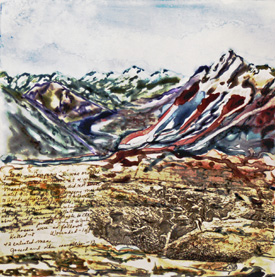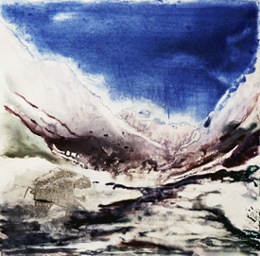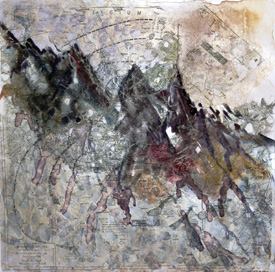
Exhibits Events Past Program Highlights 
|


Splendor and Sorrow:
Glimpses of World War I
An Exhibition by Therese Dwyer Moriarty
Contemporary Art at Historic Northampton, November 2014
 |
July 24, Tallies |
One hundred years ago the First World War began. It was called the Great War - the War to End All Wars. It was so named with good reason. The first major war in the new technological era saw major political forces trying to show off their new ‘toys’ and millions of lives paid the price. An entire generation was lost. In this Contemporary Art at Historic Northampton exhibition, printmaker Therese Moriarty balanced the awesome beauty of the Alps and surrounding countryside with the echoes of a war that changed the world, a war that instead of “ending all wars” became overshadowed a mere 20 years later on the same soil. The writings integrated into the art are metaphors for all conflicts before and since; they are the voices that go unheeded as our world teeters on the brink of disaster.
Devastation of the land all over Europe left not only physical, but emotional scars as well. The physical scars on the land are healing, the emotional ones still sting. A recent trip to France and the Alps accentuated this point to Moriarty who combined her passion for the beauty she experienced there with the after-effects of war still evident among the European citizens. Using stories from several books owned by the artist and diaries and letters from the collection at Historic Northampton, Moriarty subtly intertwined the severe messages with majestic alpine images. Splendor and Sorrow incorporates stories from some of the Northampton families who served during World War I. Maps and trench stories from other sources echo the diary writings of Captain Thomas Joseph Hammond, Company I, 104th Infantry Regiment, Northampton. Especially poignant are the letters and death notices from Pvt. Irving Finn and Sgt. George Finn, brothers killed a mere 6 months apart. Gas mask instructions were included with the contents of the footlocker used by Wallace Howes during his service in the United States Army from 1917 to 1919. With just these three local families’ items from the archives, major issues from the war reveal themselves in a very personal way.
 |
Letters Home |
 |
Where Next |
Moriarty, who works mostly in monotypes, paints with watercolors on treated Plexiglas, letting colors drip and flow into each other and emphasizing areas with drawings using bamboo calligraphy pens. Before running the plate through a printing press she transposes stories and letters onto various rice papers or uses a non-toxic lithography process to impose images from maps, photos, and death notices. These are added to the watercolor images at the time of printing. The writings are subtle and are not meant to be read. They are hints and echoes, like a nagging feeling of foreboding in our subconscious. Some of the writings are included separately in the exhibition so that they may be seen in their entirety.
About the Artist
Therese Dwyer Moriarty has been an artist and art educator for all of her adult life. She has taught art to all age levels, and currently teaches mid-elementary art in East Longmeadow. Moriarty has studied painting and printmaking here and abroad. Her work is in many private and corporate collections. She is a member of Zea Mays Printmaking.
Contents Copyright 2025. Historic Northampton.